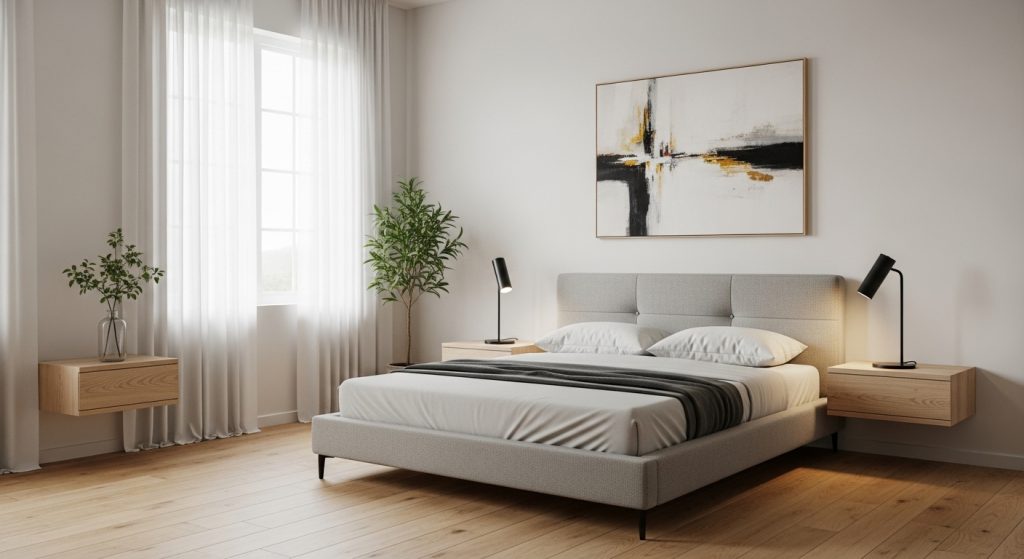Creating a serene sanctuary with modern bedroom furniture relies on embracing the principles of minimalism, clean lines, and functionality. This contemporary bedroom design approach strips away the unnecessary, focusing instead on quality materials, simple forms, and creating an atmosphere of calm sophistication. Key pieces like a minimal nightstand and a streamlined bed frame are chosen not just for their looks but for their contribution to an uncluttered and restful environment.

This definitive guide provides expert insights and sleek furniture ideas. It explores the core tenets of modern minimalism, influenced heavily by Scandinavian decor, and offers professional strategies for selecting and styling furniture to achieve an effortlessly chic and deeply calming bedroom retreat.
What Defines Modern and Minimal Bedroom Furniture?
Modern and minimal bedroom furniture is defined by its emphasis on simplicity, functionality, and clean, unadorned lines. This style prioritizes essential forms, quality materials, and a lack of ornamentation. It favors a neutral color palette and aims to create an open, airy, and calming atmosphere by eliminating visual clutter. Every piece serves a purpose and contributes to a cohesive, understated elegance.
This design philosophy stands in stark contrast to more traditional or ornate styles. Where traditional furniture might feature elaborate carvings, heavy profiles, and decorative hardware, modern minimal pieces showcase smooth surfaces, geometric shapes, and often integrated or hidden functional elements. The beauty lies in the purity of form and the quality of the materials themselves. The global appeal of minimalist design continues to surge as people seek refuge from the visual noise of modern life.
How Does “Less is More” Guide Furniture Choices?
The “less is more” philosophy is the central guiding principle. It encourages choosing fewer, better pieces of furniture rather than filling the room with many items. Each piece must justify its presence through both its function and its aesthetic contribution. This leads to a curated selection where quality trumps quantity. The focus is on essential items like the bed, nightstands, and necessary storage, executed with simple elegance. Unnecessary accent chairs, bulky armoires, or purely decorative tables are often omitted.
What is the Role of Functionality in This Style?
Functionality is paramount in modern minimal design. Furniture is not just beautiful; it is inherently practical. Storage solutions are often integrated seamlessly into the design, such as drawers built into a platform bed frame or handleless dressers that maintain a sleek facade. A minimal nightstand is chosen not only for its clean lines but also for its ability to hold necessary bedside items without contributing to clutter. Form follows function, but both are executed with a high degree of aesthetic refinement.
How Do Clean Lines Create a Sense of Calm?
Clean lines – meaning simple, straight lines or gentle curves without fussy details – are fundamental to creating a sense of calm. Our eyes perceive simple forms as orderly and restful. Uncluttered silhouettes and smooth surfaces reduce visual “noise,” allowing the mind to relax. This lack of ornamentation creates a feeling of spaciousness and serenity, which is particularly desirable in a bedroom environment designed for rest and rejuvenation. The psychological impact of clean lines on perceived calm is a recognized principle in design psychology.
What Are the Key Furniture Pieces in a Modern Minimal Bedroom?
A modern minimal bedroom focuses on essential, high-quality pieces that combine form and function seamlessly. The selection typically includes a streamlined bed frame, functional yet simple nightstands, and efficient storage solutions. Optional accent pieces are chosen with care to maintain the uncluttered aesthetic.
How to Choose a Modern Bed Frame?
The bed frame is the focal point of the room and sets the tone. Modern minimal options emphasize low profiles and simple headboards.
- Platform Beds: These are a quintessential choice. They eliminate the need for a box spring, creating a low, grounded look. Frames are often simple wood, upholstered in neutral fabric, or sleek metal. Many offer built-in storage drawers underneath.
- Simple Headboards: Look for unadorned headboards in natural wood, simple upholstered panels (linen or wool), or minimalist metal designs. Avoid elaborate tufting, carvings, or bulky shapes.
- Canopy Beds (Minimalist): A modern take uses very thin, clean-lined metal frames for a graphic, airy effect rather than heavy posts or drapery.
What Defines a Minimal Nightstand?
A minimal nightstand is characterized by its simple form, functionality, and clean lines. It provides essential bedside storage without adding visual clutter.
- Floating Nightstands: Wall-mounted shelves or small cabinets keep the floor clear, enhancing the sense of space. Ideal for very small rooms.
- Simple Geometric Shapes: Cubes, rectangles, or cylinders with minimal detailing.
- Open Shelves vs. Drawers: Open shelves offer an airy look but require curated tidiness. Handleless drawers provide concealed storage for a sleeker appearance.
- Materials: Light wood, matte lacquer, or simple metal frames often feature. Our guide on minimalist nightstand styling tips for clean interiors explores these options in depth.
What Are the Best Dressers and Storage Solutions?
Dressers and storage solutions in a modern minimal bedroom prioritize clean facades and efficient organization.
- Handleless Designs: Drawers often feature push-to-open mechanisms or integrated edge pulls for a seamless look.
- Simple Forms: Rectangular shapes with crisp edges dominate. Avoid ornate details or hardware.
- Vertical Storage: Tall, narrow dressers or wardrobes utilize vertical space effectively, which is ideal for smaller rooms.
- Quality Materials: Look for pieces made from solid wood, high-quality veneers, or smooth matte lacquer finishes. Built-in wardrobes with simple, flat-panel doors are also a hallmark of this style, keeping storage completely concealed.
Should You Include Accent Seating?
Accent seating is optional in a minimal bedroom. If included, it should be chosen carefully for its form and function. A single, beautifully designed armchair with clean lines and natural upholstery (like linen or leather) can provide a cozy reading nook. A simple bench at the foot of the bed can offer a place to sit while dressing or hold extra blankets. The piece should feel light and integrate seamlessly, not dominate the space.
What Materials Define Contemporary Bedroom Design?
The materials used in contemporary bedroom design with a minimalist leaning are chosen for their quality, natural beauty, and ability to create a serene atmosphere. The focus is on authentic materials with subtle textures and finishes that enhance the clean lines of the furniture.
Why Are Light Woods So Prevalent?
Light woods like oak, ash, maple, and birch are prevalent due to the strong influence of Scandinavian decor. These woods have a bright, airy quality that reflects light and contributes to a feeling of spaciousness. Their natural grain patterns add subtle warmth and organic texture without feeling heavy or overwhelming. A natural or matte finish is preferred to showcase the wood’s inherent beauty.
How Are Dark Woods Used Effectively?
Dark woods, such as walnut or ebonized finishes, can be used very effectively to create a more sophisticated, dramatic, or mid-century modern feel. A dark wood bed frame or nightstand can provide a beautiful grounding contrast against light walls and bedding. The key is to use these darker tones intentionally and balance them with lighter elements to prevent the room from feeling too heavy.
What is the Role of Metal Finishes?
Metal finishes are typically used as accents rather than the primary material. Simple, slender metal frames or legs (often in matte black, brushed brass, or nickel) can add a modern, graphic element to wood or upholstered pieces. Metal hardware, if used, is typically minimal and sleek. Polished chrome is less common, with softer, brushed, or matte finishes preferred.
How is Upholstery Incorporated?
Upholstery is often used for headboards, benches, or accent chairs to add softness and texture. Natural, textural fabrics are favored:
- Linen: Offers a relaxed, breathable, and subtly textured look.
- Wool/Felt: Provides warmth, coziness, and a matte finish.
- Cotton Canvas: Durable and simple.
- Leather: Adds a touch of natural luxury and develops a patina over time. Colors are typically kept within the neutral palette – shades of gray, beige, cream, or charcoal.
Can Glass or Mirror Be Used Minimally?
Glass and mirror can be used sparingly to enhance lightness or reflection. A nightstand with a simple glass top can feel less visually heavy. Mirrored closet doors are a common feature in modern bedrooms. They help to expand the sense of space and bounce light around the room. However, large pieces of mirrored furniture are generally avoided in favor of a more understated aesthetic.
How to Choose and Style a Minimal Nightstand?
Choosing and styling a minimal nightstand is a key exercise in the “less is more” philosophy. It must provide essential function without disrupting the room’s serene, uncluttered atmosphere. Every item placed on it should be chosen with intention.
How Does Function Dictate Form?
Function dictates form. First, determine your essential bedside needs. Do you need a drawer for hidden storage, or is a simple surface enough? This functional requirement will guide your choice between different minimalist designs. Our guide on bedside organization tips using small modern nightstands provides practical ideas. Options include:
- Floating Shelf: Ultimate minimalism, surface only.
- Simple Table: Legs and a top, perhaps a small open shelf.
- Cube/Box: May have one open side or a single drawer.
- Wall-Mounted Cabinet: Concealed storage, keeps floor clear.
Why is Scale Crucial, Especially in Small Rooms?
Scale is crucial. The nightstand must be proportional to the bed and the room. A nightstand that is too large will overwhelm a small bedroom. A floating or wall-mounted option is often the best choice for very tight spaces. Ensure the height aligns correctly with your mattress (level or slightly higher). Measure your space carefully before buying. Our guide to small bedroom nightstand ideas for tight spaces focuses specifically on maximizing function in minimal square footage.
What Are the Essentials for Minimalist Styling?
Minimalist styling involves ruthless editing. Only include items that are truly necessary or exceptionally beautiful. A typical setup might include:
- A Simple Lamp: Chosen for its sculptural form.
- A Phone/Charger: Neatly placed, perhaps on a wireless pad.
- One or Two Other Items: A single small plant, a beautiful alarm clock, OR a small stack of books. Avoid cluttering the surface. Our detailed guide on minimalist nightstand styling tips for clean interiors provides a step-by-step approach.
How to Create a Serene Atmosphere with a Neutral Palette?
A neutral color palette is foundational to modern minimal design. It creates a calm, cohesive, and sophisticated backdrop. The key to making a neutral room feel inviting, rather than boring, lies in the skillful layering of different tones and textures.
Why Are Neutrals So Calming?
Neutrals are calming because they are visually restful. Colors like white, gray, beige, and soft blacks do not demand attention in the way bright colors do. They create a serene atmosphere that is conducive to relaxation and sleep. This is particularly important in a bedroom, which should be a sanctuary from the stresses of the outside world. The psychological effects of color on mood are well-documented.
How to Layer Different Shades of Neutrals?
Layering different shades and tones of neutrals adds depth and prevents the room from feeling flat. Don’t just use one shade of gray; incorporate several, from light dove gray to deep charcoal. Mix warm beiges with cool grays for subtle complexity. Use crisp white for trim and ceilings to create contrast. This tonal variation creates a sophisticated, nuanced look.
Why is Texture the Secret Ingredient?
Texture is the secret ingredient that brings a neutral palette to life. When color is minimal, texture becomes the primary way to create visual and tactile interest. Incorporate a rich mix of textures through:
- Bedding: Chunky knit throws, soft linen duvet covers, smooth cotton sheets.
- Rugs: A high-pile wool rug or a flatweave jute rug adds texture underfoot.
- Furniture: The grain of wood, the smoothness of lacquer, the weave of upholstery.
- Curtains: Natural linen or textured cotton drapery. This layering of textures makes the room feel cozy, inviting, and luxurious, even within a simple color scheme.
What Sleek Furniture Ideas Maximize Small Bedroom Space?
Sleek furniture ideas are essential for maximizing both style and function in small modern bedrooms. The goal is to choose pieces that have a minimal physical and visual footprint, often incorporating clever storage solutions.
How Do Floating Elements Create Space?
Floating elements, like wall-mounted nightstands or shelves, are incredibly effective. By keeping the floor clear, they create an uninterrupted sightline, making the room feel significantly larger and airier. They provide necessary surface or storage space without consuming valuable floor real estate.
What Are the Benefits of Platform Beds with Storage?
Platform beds with built-in storage drawers underneath are a brilliant solution for small rooms. They eliminate the need for a separate, bulky dresser, freeing up floor space. Look for designs where the drawers are seamlessly integrated into the base for a clean, minimalist look. This multi-functionality is key to efficient small-space living. The market for storage beds reflects this need.
Why Choose Tall and Narrow Storage?
When choosing freestanding storage like dressers or wardrobes, opt for tall and narrow designs rather than low and wide ones. Vertical storage draws the eye upward, creating an illusion of height. It also occupies a smaller footprint on the floor, leaving more room for circulation.
How Can Mirrors Be Used Strategically?
Mirrors are a small bedroom’s best friend. Placing a large mirror on one wall can visually double the size of the space. Mirrored closet doors are another effective strategy. They bounce light around the room and eliminate the need for a separate freestanding mirror.
Conclusion
Embracing modern bedroom furniture with a minimal aesthetic is about creating more than just a stylish room; it is about crafting a personal sanctuary. By prioritizing clean lines, functional design, quality materials, and a serene neutral palette, you can achieve a space that feels calm, uncluttered, and deeply restful. From the streamlined silhouette of a platform bed to the curated simplicity of a minimal nightstand, each piece contributes to an atmosphere of effortless style and tranquility. This intentional approach to contemporary bedroom design allows you to create a sophisticated and timeless retreat that perfectly supports rest and rejuvenation.











